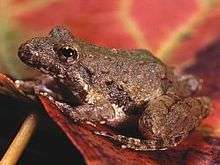Blanchard's cricket frog
Blanchard's cricket frog (Acris blanchardi) is a species of frog in the family Hylidae. It is a small, dark colored frog that is threatened or endangered in Michigan, Wisconsin, and Minnesota. Studies have been done to see why the population of the frog is beginning to decrease in those states. Blanchard's cricket frogs are commonly found in wetlands, ponds, and/or near row crop agriculture.[2] The average life span for this frog is about one year, which is why the species is considered to be short-lived. Little is known about the interactions and basic ecology, even though populations are decreasing.[3] Blanchard's cricket frog was formerly considered to be a subspecies of the northern cricket frog.
| Blanchard's cricket frog | |
|---|---|
 | |
| Scientific classification | |
| Kingdom: | Animalia |
| Phylum: | Chordata |
| Class: | Amphibia |
| Order: | Anura |
| Family: | Hylidae |
| Genus: | Acris |
| Species: | A. blanchardi |
| Binomial name | |
| Acris blanchardi | |
| Synonyms | |
| |
Description
Blanchard's cricket frogs have warty skin that is usually brown, gray, tan, or olive green, with darker bands of color on the legs. Their skin is also heavily vascularized, which may allow substances to get into their bodies quickly, increasing their susceptibility to diseases.[4] A dark, triangular mark between the eyes is frequently seen. They are small, growing to 0.6 inches (1.5 cm) in length. They generally inhabit slow-moving or stagnant bodies of water, and are the most aquatic of tree frogs in North America. They hibernate during the cold months, beginning in late October, and emerging from hibernation in late March or early April. Breeding occurs from mid-May to mid-July. Females lay small clusters or single eggs. Tadpoles emerge in late summer. Breeding males have a metallic clicking call distinctive to the species.[5][6] The subspecies is named after Frank N. Blanchard, a noted American herpetologist.[1] The frogs are most commonly found in streams and wetlands where reproduction takes place.[7] Only a few survive until the second breeding season. If a breeding season isn't productive, the population for that area can decline.[8]
Conservation
Blanchard's cricket frogs can be found through most of the Midwest United States, ranging from Michigan and Wisconsin in the north to southern Texas in the south and from Colorado in the west to West Virginia in the east.[9] Although not listed at the federal level, Blanchard's cricket frogs are considered at risk in some states. It is an endangered species in Wisconsin,[10] and is a threatened species in Michigan, due to a significant population decline since the late 1970s. Habitat loss, chemical contaminants, and competition for resources have been posited as reasons for this decline. Populations can still be found in the southern and western portions of Michigan's Lower Peninsula.[5]
A. crepitans, including A. c. blanchardi, is also considered endangered in Minnesota.[11] It may also still be on Pelee Island, Ontario, Canada, but has not been reported since 1987.[12] It was thought that competition by Bullfrogs caused a decrease in the population of Blanchard's cricket frog, however, a study found no evidence that Bullfrog tadpoles took enough resources from Blanchard's cricket frog tadpoles to impact them.[3] Another study of the immune defense traits of Blanchard's cricket frog showed that multiple factors can influence the immune system of the frog, for example water conductivity, water surface area, and ratio of natural to managed land. All of these factors were found to influence the skin microbiome of the frog, and compromise the frog's immune system.[4] While some decreases in population are due to chemical contaminants and competition for resources, the major reason for the decrease is still unknown.
References
- Beltz, Ellin (2006). "Biographies". Ellin Beltz. Retrieved 2012-08-10.
- Cusaac, J. Patrick (December 2015). "Acute toxicity of Headline fungicide to Blanchard's cricket frogs (Acris blanchardi)". Ecotoxicology – via Proquest.
- Youngquist, Melissa (August 2015). "Competitive Interactions between Cricket Frogs (Acris blanchardi) and Other Anurans". The Herpetologists' League – via EBSCOhost.
- Krynak, Katherine (January 2016). "Landscape and water characteristics correlate with immune defense traits across Blanchard's cricket frog (Acris blanchardi) populations". Biological Conservation. 193: 153–167. doi:10.1016/j.biocon.2015.11.019.
- "Blanchard's Cricket Frog (Acris crepitans blanchardi)". Michigan Department of Natural Resources. Retrieved 2012-08-10.
- "Acris crepitans blanchardi". Michigan Natural Features Inventory. Archived from the original on 2012-05-03. Retrieved 2012-08-10.
- Crawford, John (December 2017). "Chytrid Infection Dynamics in Cricket Frogs on Military and Public Lands in the Midwestern United States". Journal of Fish and Wildlife Management – via EBSCOhost.
- Hoskins, Tyler D.; Boone, Michelle D. (2017-01-20). "Variation in malathion sensitivity among populations of Blanchard's cricket frogs (Acris blanchardi) and implications for risk assessment". Environmental Toxicology and Chemistry. 36 (7): 1917–1923. doi:10.1002/etc.3715. ISSN 0730-7268.
- "Northern Cricket Frog, Acris crepitans". US Geological Survey. Archived from the original on 2012-05-27. Retrieved 2012-08-10.
- "Blanchard's Cricket Frog". Wisconsin Department of Natural Resources. Retrieved 2012-08-10.
- "Acris crepitans". Minnesota Department of Natural Resources. Retrieved 2012-08-11.
- Acris blanchardi Blanchard's Cricket Frog / Rainette Grillon de Blanchard, CARCNET